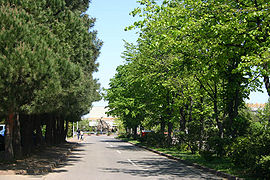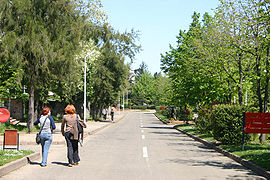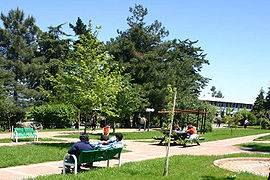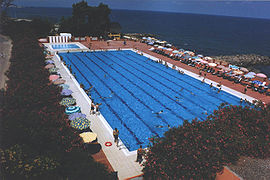
Karadeniz Technical University
Encyclopedia
Karadeniz Technical University , is a public research university in Trabzon
, in the Black Sea
region
of Turkey
. Established in 1955, it is the fourth oldest university in Turkey and the only Technical University to comprise a medical school.
The continuing development of Karadeniz Technical University is in parallel with the needs of the surrounding environment. In this respect, the faculties of Dentistry, Pharmacy, Fine Arts, Communication and Of School of Technical Education are some units to offer a good education and excellent research potential.
Today, the university, embracing the geography from Trabzon to Gümüşhane and from Ordu to Artvin, is one of the outstanding educational institutions of the country with its 18 faculties, 1 conservatory, 4 Schools, 10 Vocational Schools, 5 Institutes, 16 Research Centers, 1828 staff of high caliber and 37000 students coming from various cities.




After the establishment of the Turkish Council of Higher Education in 1981, these faculties have been united as one single faculty under the name "Faculty of Engineering and Architecture" consisting of seven departments (Civil Eng., Electrical Eng., Geodesy Eng., Geophysical Eng., Geology and Architecture). Afterwards, six more departments (Mining Eng., computer Eng., Industrial Eng., Metallurgical and Material eng., Interior Architecture and City And Regional Planning) were added to Faculty.
With decision of The Turkish Council of Ministers in 2005, Faculty of Engineering and Architecture has been cancelled, and two new faculties have been established as Faculty of Engineering and Faculty of Architecture. Faculty of Engineering has the following ten departments. All departments excluding Industrial Engineering and Metallurgical and Material Engineering are offering undergraduate program, as well as numerous graduate programs at both master's and doctoral level.
Trabzon
Trabzon is a city on the Black Sea coast of north-eastern Turkey and the capital of Trabzon Province. Trabzon, located on the historical Silk Road, became a melting pot of religions, languages and culture for centuries and a trade gateway to Iran in the southeast and the Caucasus to the northeast...
, in the Black Sea
Black Sea
The Black Sea is bounded by Europe, Anatolia and the Caucasus and is ultimately connected to the Atlantic Ocean via the Mediterranean and the Aegean seas and various straits. The Bosphorus strait connects it to the Sea of Marmara, and the strait of the Dardanelles connects that sea to the Aegean...
region
Black Sea Region
The Black Sea Region is one of Turkey's seven census-defined geographical regions . It is bordered by the Marmara Region to the west, the Central Anatolia Region to the south, the Eastern Anatolia Region to the southeast, the Republic of Georgia to the northeast, and the Black Sea to the north.-...
of Turkey
Turkey
Turkey , known officially as the Republic of Turkey , is a Eurasian country located in Western Asia and in East Thrace in Southeastern Europe...
. Established in 1955, it is the fourth oldest university in Turkey and the only Technical University to comprise a medical school.
History
Karadeniz Technical University, founded upon the approval of the proposal put forward by Mustafa Reşit Tarakçıoğlu, Trabzon deputy of the time, and his 28 friends on May 20, 1955, is the first university to be founded except for the ones established in Istanbul and Ankara. Eight years after the foundation, Department of Basic Sciences, Civil Engineering, Architecture, Mechanical Engineering and Forest Engineering faculties were established in accordance with the article 336, enacted on September 19, 1963. On December 2, 1963, the education in the university commenced in Trabzon Atatürk Secondary School, in Esentepe quarter. In 1966 the university moved to its present location. Continuing its development, the university expanded after the introduction of Earth Sciences and Medicine Faculty on October 4, 1973. After the introduction of Higher Education Article 2547 in 1981, the university continued to develop with new faculties and departments.The continuing development of Karadeniz Technical University is in parallel with the needs of the surrounding environment. In this respect, the faculties of Dentistry, Pharmacy, Fine Arts, Communication and Of School of Technical Education are some units to offer a good education and excellent research potential.
Today, the university, embracing the geography from Trabzon to Gümüşhane and from Ordu to Artvin, is one of the outstanding educational institutions of the country with its 18 faculties, 1 conservatory, 4 Schools, 10 Vocational Schools, 5 Institutes, 16 Research Centers, 1828 staff of high caliber and 37000 students coming from various cities.




Main campus (Kanuni)
- Rectorate
- Faculty of Engineering
- Faculty of Sciences
- Faculty of Letters
- Faculty of Architecture
- Faculty of Forestry
- Faculty of Economics and Administrative Sciences
- Faculty of Medicine
- Faculty of Dentistry
- Faculty of Pharmacy
- Faculty of Fine Arts
- Faculty of Law
- School of Foreign Languages
- Vocational School of Health Services
- Institutes
- Research centers
Fatih Campus
- Fatih Education Faculty
- Faculty of Communication
- School of Music and Drama
- Trabzon Vocational School
- Trabzon Vocational School of Theology
Engineering Education in Technical University
Faculty of Engineering is one of the core faculties at Karadeniz Technical University. Firstly, it has been established as three different engineering faculties namely "Faculty of Civil Engineering and Architecture", "Faculty of Mechanical and Electrical Engineering" and "Faculty of Earth Sciences" in 1963.After the establishment of the Turkish Council of Higher Education in 1981, these faculties have been united as one single faculty under the name "Faculty of Engineering and Architecture" consisting of seven departments (Civil Eng., Electrical Eng., Geodesy Eng., Geophysical Eng., Geology and Architecture). Afterwards, six more departments (Mining Eng., computer Eng., Industrial Eng., Metallurgical and Material eng., Interior Architecture and City And Regional Planning) were added to Faculty.
With decision of The Turkish Council of Ministers in 2005, Faculty of Engineering and Architecture has been cancelled, and two new faculties have been established as Faculty of Engineering and Faculty of Architecture. Faculty of Engineering has the following ten departments. All departments excluding Industrial Engineering and Metallurgical and Material Engineering are offering undergraduate program, as well as numerous graduate programs at both master's and doctoral level.
Faculties
- Faculty of Sciences
- Physics
- Chemistry
- Mathematics
- Biology
- Statistics and Computer Sciences
- Faculty of Letters
- History
- Turkish Language and Literature
- English Language and Literature
- Russian Language and Literature
- Sociology
- Faculty of Engineering
- Civil Engineering
- Mechanical Engineering
- Computer Engineering
- Electrical and Electronic Engineering
- Geodesy and Photogrammetry Engineering
- Geological Engineering
- Geophysical Engineering
- Metallurgical and Materials Engineering
- Mining Engineering
- Industrial Engineering
- Faculty of Architecture
- Architecture
- Interior Design
- Town and Country Planning
- Faculty of Forestry
- Forestry Engineering
- Forest Industry Engineering
- Landscape Architecture
- Faculty of Marine Sciences
- Fisheries Technology Engineering
- Naval Architecture and Marine Engineering
- Maritime Transportation and Management Engineering
- Departman of Economics and Administrative Sciences
- Economics
- Business Administration
- Finance
- International Relations
- Labour Economics and Industrial Relations
- Econometrics
- Public Administration
- Faculty of Medicine
- General Medicine
- Surgical Medicine
- Interior Medicine
- Fatih Faculty of Education
- Faculty of Dentistry
- Faculty of Communication
- Faculty of Fine Arts
- Department of Music and Opera
- Of Faculty of Technology
- Faculty of Law
- Faculty of Theology
- Faculty of Medical Sciences
Research and Application Centers
- History of Atatürk’s Principles and Reforms
- Computer Sciences
- Computer Aided Design-Engineering and Production
- Geographical Information Systems
- Environmental Issues
- Sea Ecology
- Electronic Communication Systems
- Landslide
- Kanuni Sultan Süleyman
- Black Sea, Caucasus and Central Asian Studies
- Materials Science and Production Technology
- Preschool Education
- Forestry
- Foreign Languages Teaching
Schools
- Trabzon School of Health Sciences
- Midwifery
- Nursing
- School of Foreign Languages

